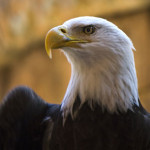Fly like an eagle
 I recently viewed a television documentary on the American bald eagle (Haliaeetus Leucocephalus). This majestic raptor, which gets its name from the old English term “balde,” meaning “white headed,” was designated the official bird and animal of the U.S. in 1782. In that year, it was estimated there were 25,000 to 75,000 of these magnificent creatures in what is now known as the lower 48 states alone. But as the country’s human population began migrating in the direction of the setting sun, many of the eagles’ nesting territories and food sources were taken over by people. On top of that, farmers at the time considered the birds to be vermin and were inclined to shoot them at every opportunity. By the turn of the 19th century, eagles were becoming increasingly rare.
I recently viewed a television documentary on the American bald eagle (Haliaeetus Leucocephalus). This majestic raptor, which gets its name from the old English term “balde,” meaning “white headed,” was designated the official bird and animal of the U.S. in 1782. In that year, it was estimated there were 25,000 to 75,000 of these magnificent creatures in what is now known as the lower 48 states alone. But as the country’s human population began migrating in the direction of the setting sun, many of the eagles’ nesting territories and food sources were taken over by people. On top of that, farmers at the time considered the birds to be vermin and were inclined to shoot them at every opportunity. By the turn of the 19th century, eagles were becoming increasingly rare.
In response to the diminishing population, the U.S. Congress passed the Bald Eagle Act in 1940, which allowed the species to experience at least some recovery in the years that followed. However, these advances were soon set back by the introduction of DDT and other pesticides that were sprayed on food crops and other plants. This vegetation was eaten by small animals, which in turn were ingested by eagles. The DDT harmed both the adult eagles, in some cases making them infertile, as well as their eggs, by causing their shells to become too thin to sustain incubation. By 1963 American bald eagle pairs had spiraled down to a mere 417.
With the threat of the extirpation of the species in the continental United States, the U.S. Congress once again came to the rescue with the passing of the Endangered Species Acts of 1966 and 1978, which included protections for the bald eagle. But the later banning of DDT in 1987 was probably the most important act of conservation afforded this beleaguered national symbol. By 1995, the U.S. Fish and Wildlife Service declared a full recovery of the species, at which time the bald eagle was removed from the “endangered species” list but remained a “threatened species.” Nearly two decades later we find the total count of bald eagles in the U.S. to be about 3,000.
In my view the selection of the eagle as a symbol of the U.S. was particularly apt, although Benjamin Franklin would disagree (more on that later). It is a strong and powerful animal that can fly at speeds of 35 miles per hour and dive at over 100 miles per hour. Some have wingspans of up to the seven feet and most have a life expectancy of 30 to 35 years in the wild. Importantly, I think many Americans strongly identify with this strong, soaring animal that bonds for life with its mate and can inflict deadly strikes with its talons when the need arises. As it is depicted on various official seals of the United States, it holds an olive branch in one talon and arrows in the other, symbols of peace and strength.
And, perhaps, its most important characteristic is that of a proven survivor. It’s worth noting that only a handful of species have fought their way back from the endangered list, such as the California gray whale, and the American alligator.
Our nation has faced many challenges throughout its history ranging from the Civil War to the Great Depression to World Wars I and II, the Korian war and, of course, the Viet Nam War. And it may be that it is on the brink of yet another threat to its continued prosperity as our federal government seems to have ground to a halt under its own weight. Thus, it is apt that our nation’s symbol would be an animal that has proven it can overcome the odds – it is a reminder that the U.S. is also a survivor. Have a happy Fourth of July.
And Benjamin Franklin? He had opined that the bird most fitting to be selected as the nation’s symbol was the turkey. I hope he was incorrect.
Pic courtesy of Flikr httpwww.flickr.comphotos27457334@N027217321828
3 comments
I had an occasion to meet an eagle up close when living in Fleming Island Florida. The eagle was seated on a low oak tree branch watching young kittens play in our yard. I walked over to speak to him about his lunch intentions and was intimated by the size of the bird. When I was within four feet of the LARGE bird he flew away. I ducked down low to the ground in order to make sure he had all the room needed for his exit. Occasionally the eagle with a young eagle student would fly over house calling to the each other and casting a large shadow on the earth below.
This was a bird that I did not want to make mad and WAS a good symbol or our country.
We, here in the Pacific North West, are lucky to have a vast number of these birds inhabiting the local airways. I’m taking up a collection to get them all toupees. Yes, they’re bald, but they don’t have to be.
A beautiful and majestic animal. One of God’s best creations.